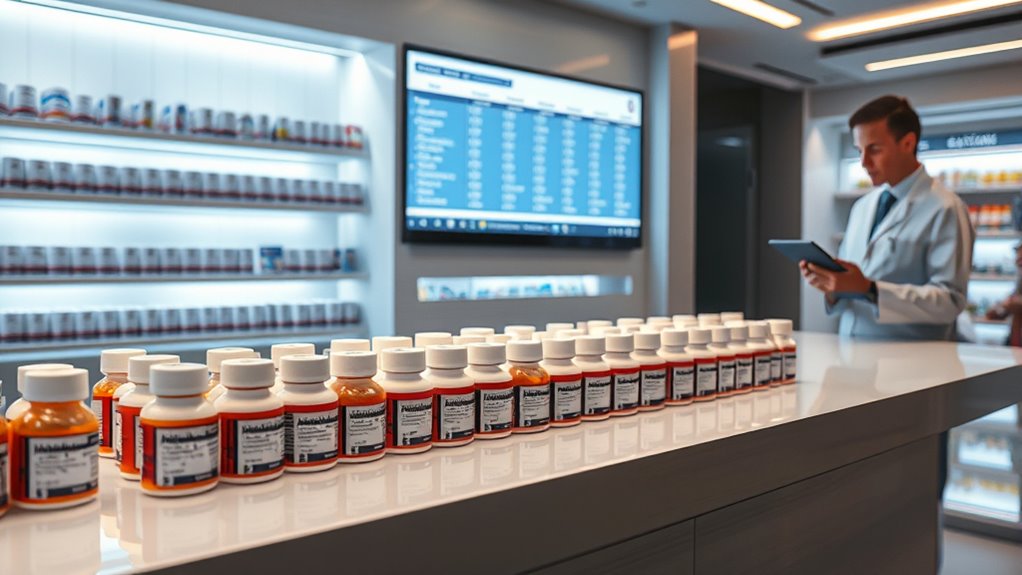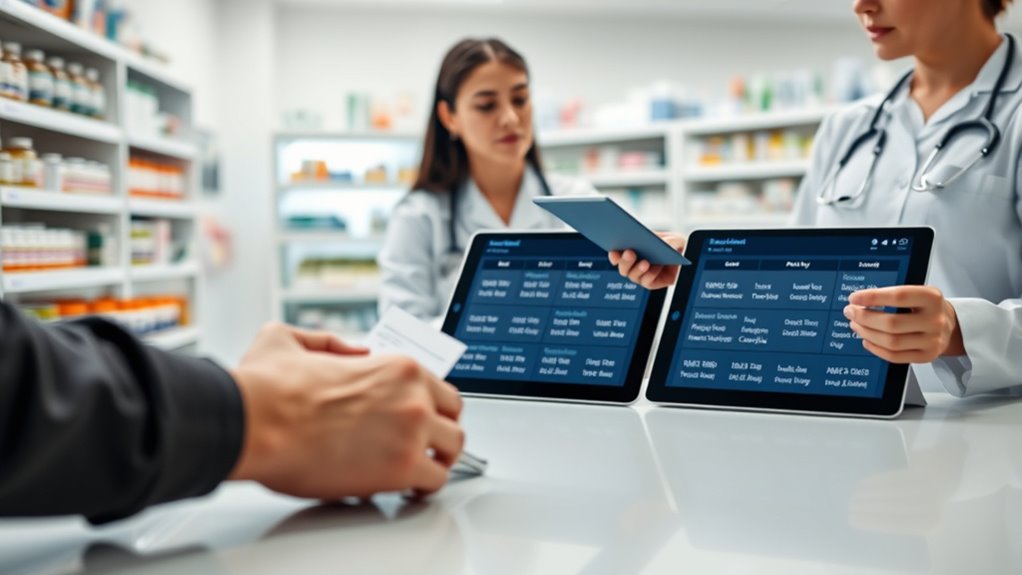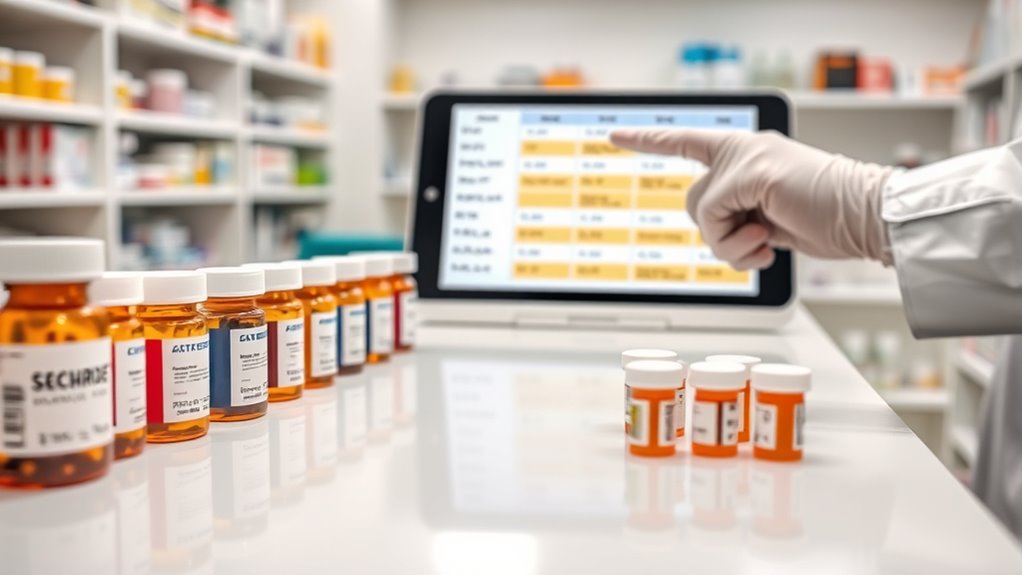Medication synchronization with pharmacies simplifies your medication routine by aligning refill dates so you can pick up all prescriptions at one time each month. This process reduces pharmacy visits, prevents missed doses, and improves medication adherence, leading to better health outcomes. Pharmacies use advanced technology to coordinate refills and keep you informed with reminders. If you want to discover how these programs can benefit you and how they work, keep exploring for more details.
Key Takeaways
- Medication synchronization aligns refill dates for all prescriptions, simplifying pickup and improving adherence.
- Advanced pharmacy software coordinates refill schedules, ensuring medications are ready simultaneously.
- Synchronization programs include tools like pill organizers, refill reminders, and personalized medication reviews.
- Effective staff training and patient education are essential for smooth implementation and sustained success.
- Addressing resistance and leveraging technology help overcome challenges and optimize medication management.
Understanding Medication Synchronization and Its Purpose

Medication synchronization is a process that aligns your prescription refill dates so you can pick up all your medications at the same time each month. This approach enhances medication clarity by reducing confusion about when to refill each prescription. It simplifies your routine, making pharmacy visits more convenient and efficient. Instead of multiple trips, you only visit once a month, saving time and effort. Synchronization also helps you stay on top of your medications, ensuring you don’t miss doses or run out unexpectedly. By coordinating refills, your pharmacy becomes a more streamlined part of your healthcare, offering better support for managing your medications. Additionally, understanding the importance of medication adherence can significantly impact your health outcomes. Overall, medication synchronization improves clarity, convenience, and adherence, making your medication routine easier and more reliable.
How Pharmacy Synchronization Programs Operate

Have you ever wondered how pharmacy synchronization programs coordinate your prescriptions? It all starts with advanced pharmacy technology that tracks your medication schedules. The program reviews your current prescriptions and identifies common refill dates. Using this data, the pharmacy aligns your medication dispensing so all prescriptions are ready at the same time. Staff then adjust refill dates if needed, ensuring minimal trips to the pharmacy. This process involves careful management of medication schedules and real-time updates through pharmacy software. The goal is to streamline your refills, reducing multiple visits and errors. Pharmacy synchronization programs operate seamlessly behind the scenes, using technology to coordinate your medications efficiently. Understanding spoiled lemon juice signs can help you ensure your medications stay safe and effective, as proper storage and handling are essential for maintaining their integrity. This coordination ensures your medication regimen stays consistent and convenient, without the hassle of managing separate refill dates.
Benefits for Patients and Healthcare Providers

Medication synchronization makes managing your prescriptions easier by consolidating refills into one visit. It also improves coordination between you and your healthcare providers, leading to better care. Additionally, it helps boost adherence rates, ensuring you stay on track with your medications. Proper projector calibration can further enhance your viewing experience by optimizing color accuracy and contrast.
Simplifies Medication Management
Ever wondered how managing multiple prescriptions can become easier for both patients and healthcare providers? Medication synchronisation streamlines this process by reducing the hassle of multiple pharmacy visits and scattered medication schedules. With synchronized refills, you can use pill organizers more effectively, ensuring doses are taken correctly and on time. It also makes medication reviews simpler, as healthcare providers can assess your overall regimen during a single appointment. This approach minimizes confusion, decreases the risk of missed doses, and enhances adherence. For providers, it simplifies tracking medication use and reduces errors. Overall, medication synchronisation offers a straightforward way to manage complex prescriptions, saving you time, improving safety, and making medication management less stressful for everyone involved. Additionally, it can support the use of targeted interventions like eye patch therapy when appropriate, to optimize overall treatment outcomes.
Enhances Healthcare Coordination
By synchronizing your prescriptions, healthcare providers can coordinate your care more effectively, guaranteeing all your medications are reviewed and adjusted simultaneously. This process improves medication safety by reducing errors and preventing harmful drug interactions. With advanced pharmacy technology, providers can access thorough medication profiles, making communication seamless and real-time. Coordinated medication management allows for better monitoring of your health needs and ensures that treatments align with your overall care plan. It also helps healthcare teams identify potential issues early, avoiding complications. Additionally, Louisiana alimony laws provide legal guidelines that support the structured management of post-divorce financial arrangements. By working together more efficiently, your providers can deliver more personalized, safe, and consistent care. Ultimately, this enhanced coordination fosters trust, reduces redundant visits, and supports better health outcomes for you.
Improves Adherence Rates
When prescriptions are synchronized, it becomes easier for you to stick to your medication schedule, substantially boosting adherence rates. Coordinated refills reduce missed doses and simplify management. Using tools like a pill organizer helps you keep track of multiple medications and avoid drug interactions. Synchronization also minimizes the risk of forgetting doses, which improves overall health outcomes. Healthcare providers appreciate better adherence because it leads to more effective treatment and fewer complications. Incorporating emotional intelligence into your medication management can foster better communication with your healthcare team and enhance adherence strategies.
Key Features and Components of Synchronization Services

Synchronization services typically include several key features designed to streamline medication management. One essential component is the use of a pill organizer, which helps you sort and track medications, reducing errors. Refill reminders are another vital feature, prompting you when it’s time to restock your prescriptions, ensuring you never run out. These services often provide coordinated pickup dates, aligning your medication refills to minimize trips to the pharmacy. Additionally, many programs offer personalized medication reviews, helping you understand your regimen better. Automated notifications or calls may also be included, keeping you informed about upcoming refills or potential issues. The integration of AI in medication management can further enhance accuracy and improve adherence. Together, these elements simplify adherence, improve safety, and make managing multiple medications more efficient.
Implementing Medication Synchronization in Pharmacies

To successfully implement medication synchronization, you need to coordinate prescription pickups so patients can collect all their medications at once. Training your staff effectively guarantees everyone understands the new process and can assist patients smoothly. Focusing on these areas helps make synchronization seamless and improves patient satisfaction. Incorporating patient education about the benefits of synchronization can further enhance adherence and trust.
Coordinating Prescription Pickups
Implementing medication synchronization starts with effectively coordinating prescription pickups to enhance patient convenience and adherence. You’ll want to set up a streamlined process for refill scheduling, ensuring all medications are ready on the same day. This reduces the number of trips patients need to make and prevents missed doses. To support this, organize pill packaging efficiently, so patients receive all their medications together, simplifying their routines. Clear communication is essential—confirm pickup dates and remind patients beforehand. By aligning refill schedules and coordinating pickups, you minimize errors and delays. This approach not only improves medication adherence but also strengthens patient trust and satisfaction. Ultimately, a well-coordinated pickup process makes medication management easier for everyone involved. Incorporating hydrocolloid technology in acne patches has been shown to promote faster healing and reduce the risk of scarring, which can also contribute to improved patient outcomes and satisfaction.
Staff Training Strategies
Effective staff training is essential for successfully implementing medication synchronization in your pharmacy. To keep your team motivated, emphasize the benefits of synchronization, such as improved patient care and workflow efficiency. Providing targeted training sessions boosts staff confidence and engagement. Encourage staff certification in pharmacy practice areas related to medication management, which enhances their expertise and credibility. Offer ongoing education opportunities to keep staff updated on best practices and new technologies. Recognize and reward staff motivation to foster a proactive, collaborative environment. Well-trained, certified staff are better equipped to handle patient inquiries, coordinate prescription pickups, and ensure smooth synchronization processes. Investing in thorough training strategies ultimately leads to more effective medication synchronization and higher patient satisfaction.
Overcoming Challenges and Ensuring Success

While medication synchronization offers clear benefits, overcoming its challenges requires careful planning and persistence. Patient engagement is essential; you need to communicate clearly and involve patients in the process to boost adherence and satisfaction. Technology integration also plays a critical role—using reliable software can streamline scheduling, tracking, and communication, reducing errors and saving time. Resistance to change from staff or patients can hinder progress, so providing ongoing training and support is indispensable. Regularly reviewing workflows and addressing issues promptly will help keep the process on track. Understanding Narcissism can also be helpful in managing staff and patient interactions, ensuring a more empathetic and effective approach. By prioritizing open communication, leveraging technology effectively, and maintaining flexibility, you can overcome obstacles and guarantee the successful implementation of medication synchronization in your pharmacy.
Frequently Asked Questions
How Does Medication Synchronization Impact Pharmacy Workflow Efficiency?
You’ll find that medication synchronization boosts pharmacy workflow efficiency by reducing the number of pharmacy visits and streamlining medication dispensing. This approach improves medication adherence, ensuring patients stay consistent with their treatments. With pharmacy automation, tasks become faster and more accurate, allowing staff to focus on patient care rather than manual processes. Overall, it creates a more organized system, saving time and enhancing service quality for both you and your patients.
Are There Specific Medications Excluded From Synchronization Programs?
Back in the day, folks relied on simple routines, and today, medication sync isn’t much different. You should be aware some medications are excluded from synchronization programs due to medication restrictions and exclusion criteria. These typically include drugs with complex dosing, specialty medications, or those needing close monitoring. Knowing these exclusions helps ensure smooth pharmacy operations and safe patient care, preventing potential mix-ups or adverse effects.
What Training Is Required for Pharmacy Staff to Implement Synchronization?
You need to guarantee your pharmacy staff completes specific training modules to effectively implement synchronization. Staff certification is essential, as it verifies their understanding of the process. These training modules cover medication management, patient communication, and workflow adjustments. By completing this training, your team becomes proficient in synchronization procedures, helping to improve medication adherence and streamline pharmacy operations. Proper certification and training are key for successful implementation.
How Do Patients Customize Their Medication Synchronization Plans?
Imagine your medication plan as a tailor-made suit, fitting your lifestyle perfectly. You can customize your personalized medication plan by discussing your routine, preferences, and health goals with your pharmacist. They’ll help you develop strategies that suit your schedule, ensuring better adherence. Your active engagement is key—share your concerns and routines. Together, with personalized medication plans and patient engagement strategies, you’ll create a synchronization plan that feels like it was made just for you.
What Privacy Considerations Are Involved in Synchronization Data Management?
When managing synchronization data, you need to prioritize privacy considerations. You should guarantee data security by using strong encryption and secure storage methods. Confidentiality protocols are essential to prevent unauthorized access and protect your personal health information. Regular audits help identify vulnerabilities, and staff training ensures everyone understands privacy responsibilities. By following these practices, you maintain trust and comply with legal standards, safeguarding your sensitive medication details effectively.
Conclusion
Implementing medication synchronization can greatly improve your pharmacy experience and health outcomes. Studies show that patients enrolled in synchronization programs are 20% more likely to adhere to their medication schedules, reducing hospital visits. By working with your pharmacy to coordinate your refills, you simplify your routine and guarantee consistency in your treatment. Embracing these services not only benefits your health but also helps your healthcare providers deliver better, more efficient care.









